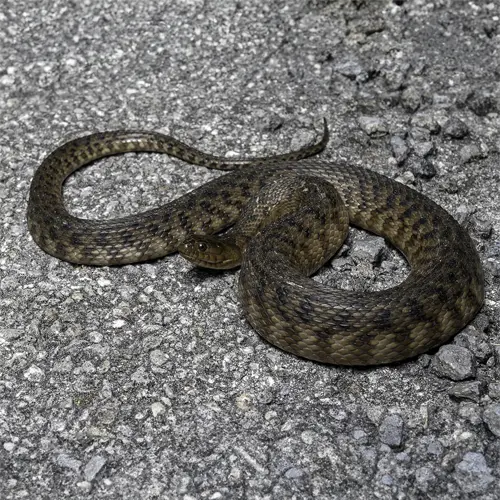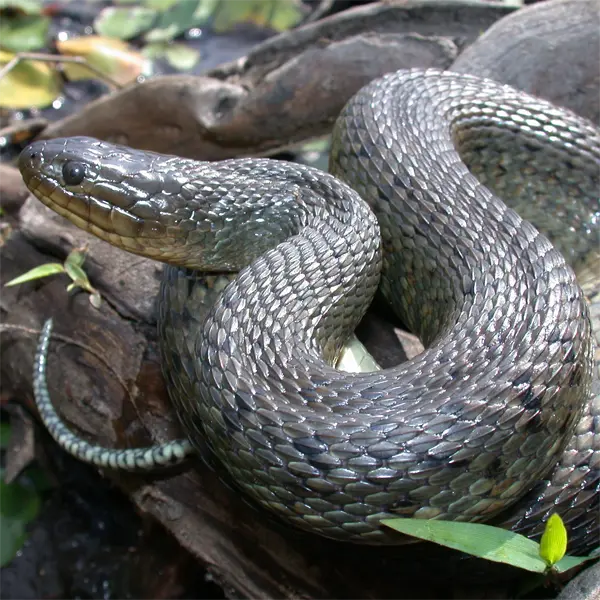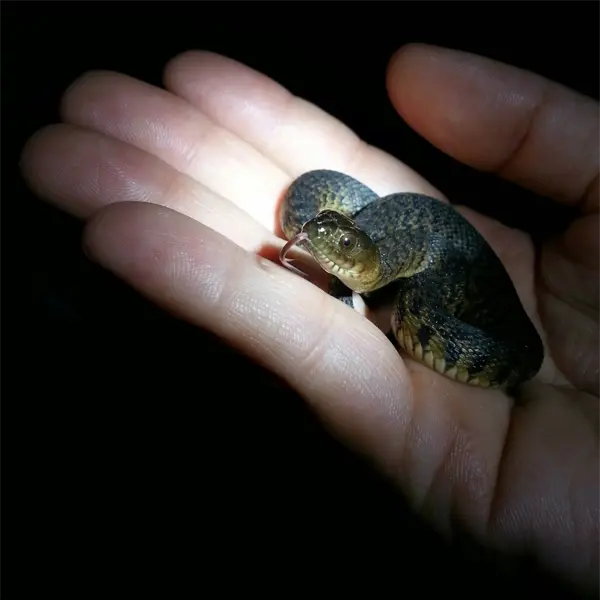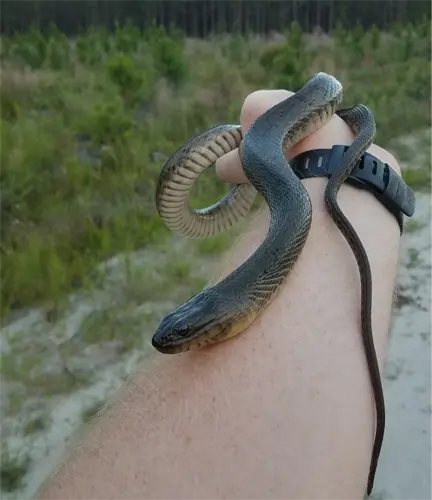Florida Green Water Snake
- Scientific Name
- Nerodia floridana
- Also Known As
- Florida Green Watersnake
- Range
- All of Florida except Jacksonville Area
- Diet
- Amphibians, Small Fish
- Life Expectancy
- 10 Years
Quick Links
Florida Green Water Snake in Central Florida
The Florida green water snake (Nerodia floridana) is a non-venomous colubrid species found throughout Florida and parts of southern Georgia. As its name suggests, this snake inhabits aquatic environments and is an excellent swimmer.
The green water snake is a key predator in wetland ecosystems but is also found around urban areas. This guide provides identification tips, biology facts, and information on habits, diet, reproduction, health risks, and prevention of conflict with the Florida green water snake in central Florida.
Appearance and Identification
The Florida Green Water Snake can be distinguished from look-alike species by the following characteristics
When basking, the Florida green water snake often rests with its body in an S-shape. The rough, keeled dorsal scales help identify the snake in hand. The yellow-checked lips and aquatic habitat preference distinguish them from similar rat snakes.
Maturation Rate
Young Florida green water snakes grow rapidly to adult size. They average 18 inches (45 cm) long at 3-4 months old and 24 inches (60 cm) by one year old. Sexual maturity accompanies their attainment of adult length by ages 2-3.
Hatchlings feed heavily on tadpoles and small fish to fuel their accelerated growth. Shedding occurs frequently as the snakes increase in size. Defensive behaviors like musk secretion develop within a few weeks after birth. The snakes are reproductively mature and full-grown by their second spring season.
Habits and Behavior
The Florida green water snake leads a highly aquatic lifestyle rarely venturing onto dry land. It is most active during the day, spending mornings basking on branches overhanging water. If disturbed, the snakes dive into water and hide among aquatic plants. They are strong swimmers propelled by lateral undulation of their bodies and tails.
Florida green water snakes are non-aggressive and utilize escape as their primary defense. They do not pose a danger to humans unless severely threatened, in which case they may bite in self-defense. The bite is not medically significant. These snakes often inhabit developed areas and urban wetlands, attracted by amphibian prey.
Reproduction and Lifespan
Florida green water snakes reach sexual maturity by 2-3 years of age. Mating occurs in the spring following emergence from winter dormancy. Males engage in combat to compete for access to females. After mating, females seek suitable nesting sites on land near water.
The clutch size ranges from 10-30 eggs which are laid between April and July. The female deposits the eggs in moist soil, compost, mulch, or sawdust and provides no parental care. The eggs hatch after 60-70 days of incubation. Hatchlings are immediately self-sufficient.
In the wild, Florida green water snakes live approximately 10 years though individuals over 20 years old have been recorded in captivity. Their secretive nature makes it challenging to determine longevity in wild populations.
Ideal Habitat and Range
Central Florida’s hot, humid climate with abundant rainfall provides ideal habitat for Florida green water snakes. Average temperatures range from the 60s°F (15-20°C) in winter to over 90°F (32°C) in summer. Total annual rainfall exceeds 50 inches (127 cm).
These conditions support expansive freshwater wetlands, cypress swamps, marshes, lakes, rivers, and streams where the snakes thrive. Abundant amphibian populations provide a consistent prey base. Urbanization brings green water snakes into suburbs where drainage canals, retention ponds, and fish ponds offer sufficient habitat.
The high humidity allows for adequate skin hydration while the snakes swim and slither through dense vegetation. Winter warming allows year-round activity. The wetlands and waterways of central Florida thus provide a plentiful food web and ideal climate for the Florida green water snake to flourish.
Diet and Feeding
Florida green water snakes are carnivorous predators that feed almost exclusively on amphibians as well as small fish. Their key prey items include:
- Frogs – especially bullfrogs, pig frogs, leopard frogs
- Toads – southern toads, oak toads, Fowler’s toads
- Salamanders – lesser sirens, two-toed amphiumas
- Tadpoles
- Small fish – mosquitofish, killifish, live-bearers
Hunting occurs during daylight hours. The snakes stealthily stalk along water’s edge searching for prey. They consume prey live underwater, holding it in their jaws until drowned. Meals average 1-2 times per week depending on prey size. These snakes can consume up to 1/3 of their body mass in a single feeding.
In urban areas, backyard koi ponds may attract hunting by green water snakes. These opportunistic predators consume any appropriately sized vertebrate prey they encounter in freshwater habitats. Fish owners may resort to excluding snakes from pond areas to protect valued specimens.
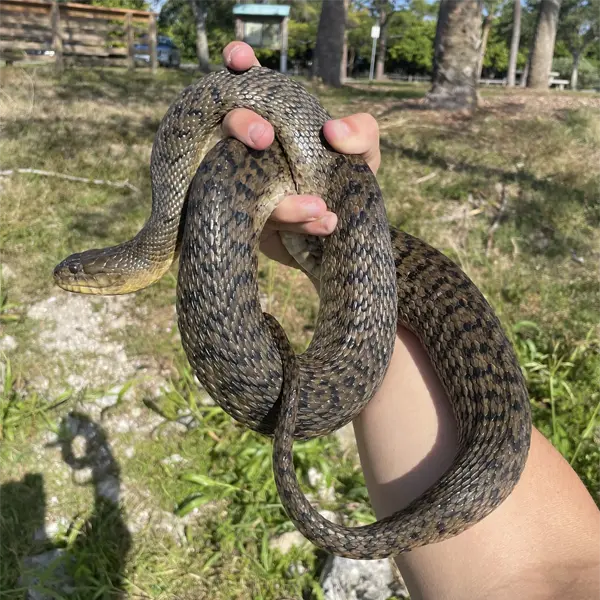
Photo 188076325 © gotcritters, CC BY-NC

Common Health Risks
Florida green water snakes pose minimal health risks to humans. Their saliva contains mild toxins that help subdue amphibian prey but is not medically significant to humans beyond minor swelling. Musk secreted when threatened is foul-smelling but harmless.
While non-venomous, green water snakes can bite if severely provoked with their small, rear-facing teeth. These defensive bites rarely break skin and do not transmit any diseases. The snakes are not known to carry salmonella or other zoonotic pathogens.
Green water snake populations provide an important check on disease-carrying mosquitoes by preying heavily on the aquatic larval and pupal stages. By reducing mosquito numbers, the snakes may lower human risk of contracting vector-borne ailments like West Nile virus.
On rare occasions, green water snakes may prey on larval salamanders containing enough tetrodotoxin to become toxic but this poses no direct risk to humans. Overall, the Florida green water snake is harmless to people and helps control pests.
Preventing Florida Green Water Snakes
Florida green water snakes gravitate toward human-created habitats like ponds, canals, and lakes in residential areas. While not dangerous, some homeowners prefer to prevent the snakes from entering yards and pools. Measures like installing snake fence barriers and removing vegetation around water edges limits snake access.
Plugging any sewer pipe openings, repairing water meter boxes, and sealing gaps in pond edging helps exclude snakes. Traps can remove individual nuisance snakes entering properties. Harassment and killing snakes is strongly discouraged – translocation back to natural wetlands is recommended for captured individuals.
Chemical control or widespread extermination campaigns are unnecessary given the lack of danger from green water snakes. Their presence around urban waterways indicates a healthy freshwater ecosystem and should be viewed positively overall. Allowing green water snakes to thrive in neighborhood wetlands maintains balance and reduces disease-spreading pests.
Photo 78064047 © Ben Stegenga, CC BY-NC
Florida Green Water Snakes in Central Florida – Conclusion
The Florida green water snake is an integral part of central Florida’s wetlands, enhancing biodiversity and controlling pest species and invasive fish. While not dangerous, green water snakes readily adapt to urbanization and may enter residential water features in search of amphibian prey.
Exclusion techniques, removal of individual nuisance snakes, and retention of buffer wetlands can prevent conflicts with homeowners. Wise coexistence allows healthy populations of green water snakes to control pests while avoiding unwanted interactions. Continued efforts to conserve central Florida’s wetland networks provides essential habitat for the Florida green water snake’s crucial ecological role.

